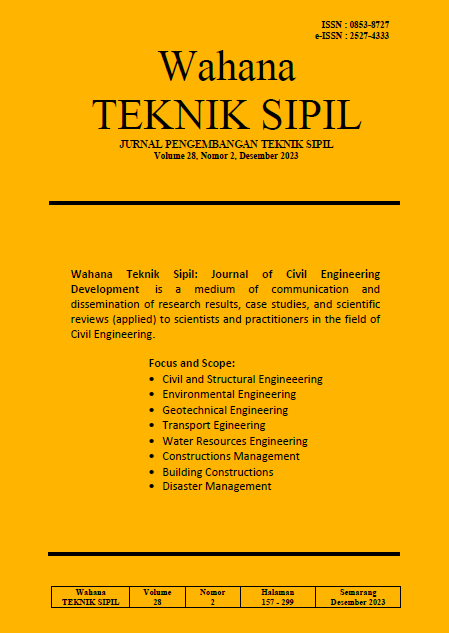PENGARUH PENAMBAHAN VERMIKULIT TERHADAP KUAT LENTUR BETON MUTU RENDAH DENGAN SIMULASI BANJIR AIR LAUT
DOI:
https://doi.org/10.32497/wahanats.v28i2.5240Keywords:
beton vermikulit, kuat lentur, air lautAbstract
The condition of high tides causing flooding or what is called tidal flooding is a condition that has a negative impact on the surrounding area, especially construction buildings. Construction buildings that are submerged in sea water can experience corrosion in the building structure. The addition or substitution of certain ingredients that can minimize the influence of minerals and salts contained in sea water, such as vermiculite, can be an alternative to this problem. Vermiculite material has the ability to absorb water and can extract heavy metal salts from water. This research was carried out by adding vermiculite to the concrete mixture at 0% (normal concrete), 12%, 24% and 36%, which was then tested on fresh concrete mixture (slump and bulk density testing). The test object used is in the form of a block with dimensions of 100mm × 100mm × 500mm. Concrete flexural strength testing was carried out on test objects that had been soaked using sea water and ordinary water as a comparison. The highest flexural strength value of concrete was in the mixture with a percentage value of 36%, namely 2.91 MPa for concrete submerged in sea water and 2.86 MPa for concrete submerged in plain water. The addition of vermiculite material can increase the flexural strength value of concrete along with the percentage level of the vermiculite mixture.
References
Akpokodje, O.I., Uguru, H., & Esegbuyota, D., 2019, Studyof Flexural Strength and Flexural Modulus of Reinforced Concrete Beams with Raffia Palm Fibers. World Journal of Civil Engineering and Construction Technology, 3, 57”“64.
Amalia, D., & Hendry, D., 2014, Kajian Peningkatan Nilai CBR Tanah Lempung Padalarang yang Distabilisasi Dengan Vermikulit dan Semen. ATPW.
Ekinci, C.E., & Kelesoglu, O., 2014, A study on occupancy and compressive strength of concrete with produced injection method. Advances in Materials Science and Engineering, 2014.
Erofeevskya, L.A., & Aleksandrov, A.R., 2021, Vermiculite of the Inagli Field as a Promising Material for Environmental Use at Reclamation Sites. IOP Conference Series: Earth and
Koksal, F., Gencel, O., & Kaya, M., 2015, Combined effect of silica fume and expanded vermiculite on properties of lightweight mortars at ambient and elevated temperatures. Construction and Building Materials, 88, 175”“187.
Mo, K.H., Lee, H.J., Liu, M.Y.J., & Ling, T.C., 2018, Incorporation of expanded vermiculite lightweight aggregate in cement mortar. Construction and Building Materials, 179, 302”“306.
Schackow, A., Effting, C., Folgueras, M.V., Güths, S., & Mendes, G.A., 2014, Mechanical and thermal properties of lightweight concretes with vermiculite and EPS using air-entraining agent. Construction and Building Materials, 57, 190”“197.
Triana, Y.T., & Hidayah, Z., 2020, Kajian Potensi Daerah Rawan Banjir Rob Dan Adaptasi Masyarakat Di Wilayah Pesisir Utara Surabaya. Juvenil:Jurnal Ilmiah Kelautan Dan Perikanan, 1 (1), 141”“150.
Wedhanto, S., 2017, Pengaruh Air Laut Terhadap Kekuatan Tekan Beton yang Terbuat dari Berbagai Merk Semen yang Ada di Kota Malang. JURNAL BANGUNAN, 22 (2), 21”“30.
Downloads
Published
Issue
Section
License
Authors who publish with this journal agree to the following terms:Authors retain copyright and grant the journal right of first publication with the work simultaneously licensed under a Creative Commons Attribution License that allows others to share the work with an acknowledgement of the work's authorship and initial publication in this journal.
Authors are able to enter into separate, additional contractual arrangements for the non-exclusive distribution of the journal's published version of the work (e.g., post it to an institutional repository or publish it in a book), with an acknowledgement of its initial publication in this journal.
Authors are permitted and encouraged to post their work online (e.g., in institutional repositories or on their website) prior to and during the submission process, as it can lead to productive exchanges, as well as earlier and greater citation of published work (See The Effect of Open Access).






